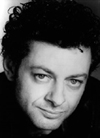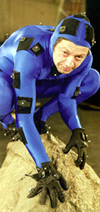The Man Who Would Be Gollum: LOTR's Andy Serkis
 |
 |
|
Author/actor Andy Serkis, aka Gollum
|
|
Lord of the Rings movie fans who assume the character Gollum is simply the creation of some software, a man at a keyboard, and a group of animators are in for a bit of a surprise: Gollum is more human (and hobbit) than might be imagined.
The magic behind the on-screen Gollum is detailed in a new title from Houghton Mifflin, Gollum: How We Made Movie Magic by actor Andy Serkis, aka Gollum, in The Lord of the Rings movie trilogy.
 In Gollum, Serkis details how his role in the film evolved from being hired to provide only the voice of an animated creature to the point where, in many ways, he was the Gollum that the audience sees on film. Or perhaps, Gollum was more like Serkis, as the animators ultimately recreated the creature's facial muscles and structure to align more closely with Serkis' face. And, by the time the third film was shot, animators were converting Serkis' movements real-time to film. The result was an animated character that has the subtle movements and emotional range of a human being.
In Gollum, Serkis details how his role in the film evolved from being hired to provide only the voice of an animated creature to the point where, in many ways, he was the Gollum that the audience sees on film. Or perhaps, Gollum was more like Serkis, as the animators ultimately recreated the creature's facial muscles and structure to align more closely with Serkis' face. And, by the time the third film was shot, animators were converting Serkis' movements real-time to film. The result was an animated character that has the subtle movements and emotional range of a human being.
Serkis' book is a lively look at how he, the writers, directors, and animators worked together to make Gollum entirely believable and real.
Bookselling This Week recently had the opportunity to speak to Andy Serkis during a visit to New York to promote the film version of The Return of the King and his new book.
BTW: In your book, you refer to Gollum as a "ring junkie." Why is that?
A.S.: As part of the acting process, one tries to find touchstone characters or people or real things that an audience will associate with. For me, whenever I get into a role, that's very important. [Gollum] is a manifestation of what the ring does to an individual. It was very important to find this analogy.
Now, it seems very obvious, but it was something that I searched for. It was just the sense that, at the end of the day, that enabled me to play him as someone who the audience could have pity for. That … he is not in control of what he does. And I know a number of people who are suffering or recovering alcoholics and addicts, and understand … I have to have a certain amount of pity for their actions, and sometimes their actions are not great, they're despicable. At the same time, [Gollum] is a flawed human being.
What I am really pleased about in the third film is, we finally get to see the origins of the character … and that for me is one of, perhaps, the most crucial scenes, because we then get to realize he was never really entirely a malicious character…. [H]e's just morally weak…. In the way that we played [Gollum's] murder of Déagol, it could have gone either way…. You know, Déagol could have been stuck with the ring.
BTW: How did playing this complex character for four years affect you?
A.S.: It was very lonely at times, and I did isolate myself. I spent quite a lot of time during the actual principal photography on my own…. A lot of that had to do with the fact that I found it necessary to inhabit the roll. I'm not saying I didn't have any friends, because we did all get along. The whole part of it being a family down there was absolutely true, and I felt very connected to people.
But also, it's strange -- I did think that here was a character that I could really hide behind as an actor. Oddly enough, I think I have drawn on my own failings, or my own dark side, more than perhaps any other character I've ever played. I think that's having the luxury of playing a character over four years and getting to really get down and dirty with it.
BTW: One of the most powerful aspects of these movies is that director Peter Jackson approaches the Lord of the Rings as if this were real history.
A.S.: Yeah. Which is exactly, of course, how Tolkien wrote the books. He wrote them as if the world were real, as if the mythology were real and had happened…. So, when everyone stepped off the plane in Wellington [New Zealand] for the first time, you just knew you were going to be part of something [that] had great authorship and authenticity. In the wrong hands this could have been such a disaster…. [Peter and the screenwriters] wanted to tell Tolkien's story, but at the same time, make it resonate in the modern world and have currency now.
BTW: You wrote that your inspiration for Gollum's voice was your cat coughing up a hairball?
A.S.: That's right. That was certainly a big part of it. That, and wanting to locate where Gollum carried his pain as a character. The cats, when they do their involuntary spasms…. Have you ever seen them [cough up a hairball]? They kind of go, [makes wretching noise], so that became [does Gollum voice], "Gollum! Gollum!"
BTW: It's interesting how people really identify with Gollum.
A.S.: I think it's that sense of him being so flawed.… Pete called him a folk hero, which I think is right in a way. He comes from a rich kind of tradition, which I dip into [in the book] … of other characters from other mythologies … including Shakespeare, Dickens, Greek mythologies, and Biblical stories. He is a "Biblical" character, obviously.
On top of that, he's … someone who you work with in the office, who you don't really like, but you feel sorry for. And then one day [this person will] do something that will break your heart. And you know you don't trust them, but you know that … they just can't help themselves from being who they are.
And I think that's why people like [Gollum].
Also, it plays to their own sense of mischief and their dark sides. You're not telling me that when he starts calling Sam a "fat hobbit" that people don't kind of get off on that, you know, because they do! And it's very obvious. So, it's asking questions, I think, and that was the one thing I wanted to do with the performance -- ask the audience to examine themselves, without presenting the answers. Just ask questions about what their worldview is. --Interview by David Grogan

